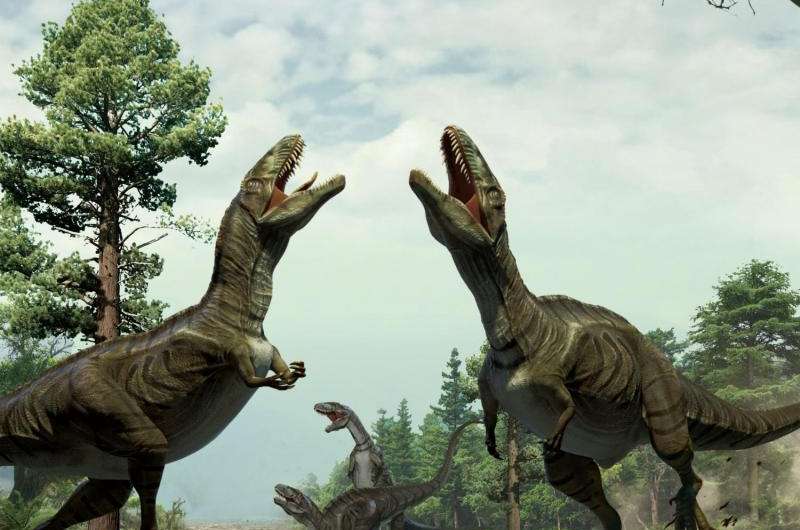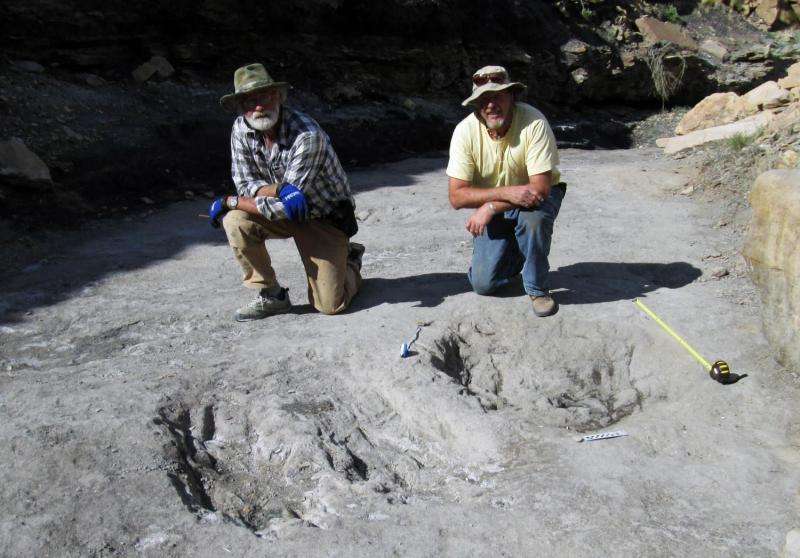Discovery shows dinosaurs may have been the original lovebirds

Dinosaurs engaged in mating behavior similar to modern birds, leaving the fossil evidence behind in 100 million year old rocks, according to new research by Martin Lockley, professor of geology at the University of Colorado Denver.
Lockley, a paleontologist, led an international research team that discovered large 'scrapes' in the prehistoric Dakota sandstone of western Colorado. These ancient scrapes are similar to a behavior known as 'nest scrape display' or 'scrape ceremonies' among modern birds, where males show off their ability to provide by excavating pseudo nests for potential mates.
"These are the first sites with evidence of dinosaur mating display rituals ever discovered, and the first physical evidence of courtship behavior," Lockley said. "These huge scrape displays fill in a missing gap in our understanding of dinosaur behavior."
The study will be published in the journal Scientific Reports on January 7.
Lockley, a world-renowned expert on dinosaur footprints, found evidence of more than 50 dinosaur scrapes, some as large as bathtubs, in an area where tracks of carnivorous and herbivorous dinosaurs have also been confirmed. The display arenas, also called 'leks' were found in two National Conservation Areas (Dominguez-Escalante and Gunnison Gorge) on property permitted by the Bureau of Land Management near Delta, Colorado.
Lockley also discovered evidence of mating areas at Dinosaur Ridge, a National Natural Landmark, just west of Denver.

This new fossil evidence supports theories about the nature of dinosaur mating displays and the evolutionary driver known as `sexual selection.' Since prehistoric times, males looking for mates, have driven off weaker rivals. Females, meanwhile, have chosen the most impressive male performers as consorts.
Similar sexual selection behaviors are common in mammals and birds. But until now scientists could only speculate about dinosaur mating behavior, assuming it might be similar to that of their modern relatives, the birds.
"The scrape evidence has significant implications," said Lockley. "This is physical evidence of pre-historic foreplay that is very similar to birds today. Modern birds using scrape ceremony courtship usually do so near their final nesting sites. So the fossil scrape evidence offers a tantalizing clue that dinosaurs in 'heat' may have gathered here millions of years ago to breed and then nest nearby."
Lockley and his team were unable to remove the scrape marks from the gigantic slabs of rock without damaging them. Instead, they created 3-D images of the scrapes using a technique of layering photographs called photogrammetry. They also made rubber molds and fiberglass copies of the scrapes that are being stored at the Denver Museum of Nature & Science.
More information: Scientific Reports, dx.doi.org/10.1038/srep18952
Journal information: Scientific Reports
Provided by University of Colorado Denver




















